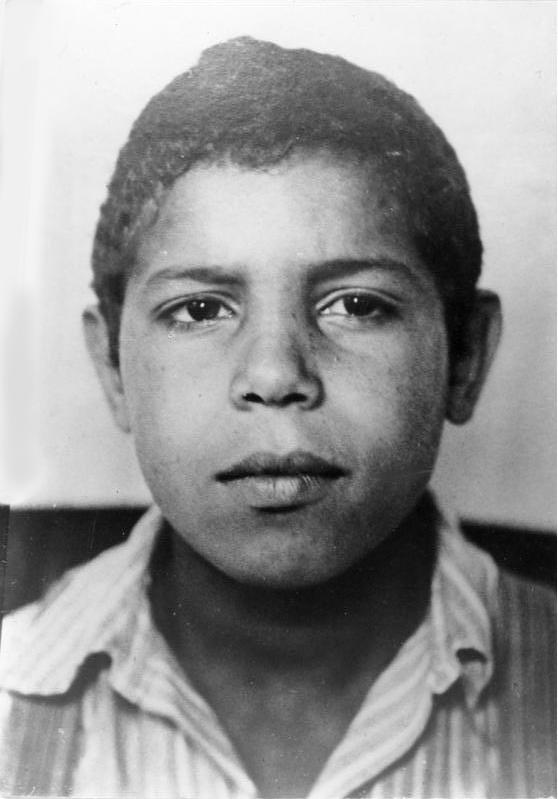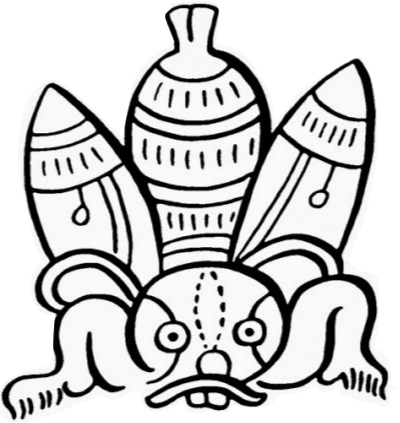
ラインラントの混血児たち(バスタード)
Rhineland Bastard, Rheinlandbastard
ナチス政権下で「混血」かつ「遺伝的疾患」と分類されたラインラント出身の青年
ラインラント・バスタード(ドイツ語:Rheinlandbastard)は、第一次世界大 戦後フランスに占領されていたラインラントに駐留していたアフリカ系のフランス軍兵士が生んだとされるアフロ・ジャーマンを指す蔑称である。
「残虐、獣性、平等」。1923年1月に送られたドイツのポストカード。フランス軍に所属するセネガル人男性とチェコ人兵士が一緒に描かれている。
| Rhineland
Bastard (German: Rheinlandbastard) was a derogatory term used in Nazi
Germany to describe Afro-Germans, believed fathered by French Army
personnel of African descent who were stationed in the Rhineland during
its occupation by France after World War I. There is evidence that
other Afro-Germans, born from unions between German men and African
women in former German colonies in Africa, were also referred to as
Rheinlandbastarde. After 1933, under Nazi racial theories, Afro-Germans
deemed to be Rheinlandbastarde were persecuted. They were rounded up in
a campaign of compulsory sterilization |
ラ
インラント・バスタード(ドイツ語:Rheinlandbastard)は、第一次世界大戦後フランスに占領されていたラインラントに駐留していたアフリ
カ系のフランス軍兵士が生んだとされるアフロ・ジャーマンを指す蔑称である。1933年以降、ナチスの人種理論のもと、ラインラントバス
タードとみなされたアフロ・ドイツ人は迫害されることになった。彼らは強制不妊手術のキャンペーンで検挙された。 |
| The
term "Rhineland Bastard" can be traced to 1919, just after World War I,
when Entente troops, most of them French, occupied the Rhineland.[2]
The British historian Richard J. Evans suggests the number of
mixed-race children among them was not more than five or six hundred.[3] All World War I belligerents with colonial possessions went to great lengths to recruit soldiers from their colonies. Germany was the only one of the Central Powers with substantial overseas possessions; it used numerous non-white troops to defend its colonies. Regardless of German attitudes toward the indigenous inhabitants of German colonies, Germany's lack of control of the sea lanes would have made it nearly impossible for the German Army to bring any substantial number of colonial troops to European battlefields. Notwithstanding the exact circumstances, most Germans quickly came to view non-white Allied troops with disdain and were contemptuous of the Allies' willingness to use these troops in Europe.[citation needed] Germans across the political spectrum regarded the occupation as a national disgrace. Many considered all forms of collaboration and fraternization with the occupiers as immoral (if not illegal) treason. From the spring of 1920 onward, German newspapers frequently ran hysterical stories about the alleged "Black Horror on the Rhine", accusing Senegalese soldiers of routinely gang-raping thousands of German women and girls on a daily basis.[4] In the popular 1921 novel Die Schwarze Schmach: Der Roman des geschändeten Deutschlands (The Black Shame A Novel of Disgraced Germany) by Guido Kreutzer, he wrote that all mixed race children born in the Rhineland are born "physically and morally degenerate" and are not German at all.[5] Kreutzer also declared that the mothers of these children ceased to be German the moment they had sex with non-white men, and they could never join the Volksgemeinschaft.[5] As Germans considered the occupation to be carried out by "B-grade" troops (a notion that was drawn from colonial and racial stereotypes), their humiliation was heightened, increasing hostility toward the women and children in these unions.[6] In May 1920 the foreign minister of the new German government lodged a protest to his French counterpart stating that "we will accept the inferior discipline amongst your white troops if you will only rid us as fast as possible of this black plague".[7] In the Rhineland itself, local opinion of the troops was very different. The soldiers were described as "courteous and often popular", possibly because French colonial soldiers harbored less ill-will towards Germans than war-weary French occupiers.[8] In his book Mein Kampf, Adolf Hitler described children resulting from any kind of relationship to African occupation soldiers as a contamination of the white race "by Negro blood on the Rhine in the heart of Europe."[9] He thought that "Jews were responsible for bringing Negroes into the Rhineland, with the ultimate idea of bastardizing the white race which they hate and thus lowering its cultural and political level so that the Jew might dominate."[10] He also implied that this was a plot on the part of the French, since the population of France was being increasingly "negrified".[11] |
ラ
インラント・バスタード」という言葉は、第一次世界大戦直後の1919年、フランス人を中心とする連合軍がラインラントを占領したときにまで遡ることがで
きる[2]。 イギリスの歴史家リチャード・J・エヴァンスは、彼らの中の混血児は5〜600人を超えなかったと示唆している[3]。 第一次世界大戦の交戦国のうち、植民地を保有していた国はすべて、植民 地から兵士を集めるために多大な努力を払っていた。ドイツは、中央列強の中で唯一、海外に大きな領土を有しており、植民地を守るために多くの非白人部隊を 使用した。ドイツが植民地の先住民に対してどのような態度をとるかは別として、ドイツがシーレーンを 支配していなかったため、ドイツ陸軍がヨーロッパの戦場に相当数の植民地兵を投入するこ とは不可能に近かったのであろう。正確な状況とは関係なく、ほとんどのドイツ人はすぐに非白人の連合軍を軽蔑の目で見るようになり、連合軍がヨーロッパで これらの軍隊を使おうとしていることを軽蔑した[citation needed]。 ドイツ人は政治的な観点から、この占領を国家の恥だと考えていた。多くの人々は、占領軍とのあらゆる形態の協力や友好関係を、(違法ではないにせよ)不道 徳な反逆行為とみなした。1920年の春以降、ドイツの新聞は「ライン川の黒い恐怖」と称するヒステリックな記事を頻繁に掲載し、セネガル人兵士が日常的に何千人ものドイツ人女性や少女を集団レイプしていると非難した[4]。 1921年の人気小説『Die Schwarze Schmach: クロイ ツァーは、ラインラントで生まれた混血児はすべて「肉体的にも道徳的にも退化して」生まれ、ドイツ人ではないと書いている[5]。また、こ れらの子供の母親は、非白人男性とセックスした瞬間にドイツ人でなくなり、ヴォルクゲマインシャフト(=民族友愛共同体: Volksgemeinschaft)に入ることはできないと宣言している[5]。 ※4: Nelson, Keith (1970). "The 'Black Horror on the Rhine': Race as a Factor in Post-World War I Diplomacy". The Journal of Modern History. 42 (4): 606–627. doi:10.1086/244041. S2CID 144070894 1920年5月、ドイツ新政府の外務大臣はフランス側に対して、「この 黒い疫病をできるだけ早く取り除いてくれるなら、あなた方の白人部隊の劣悪な規律も受け入れる」と抗議している[6]。 ラインラントでは、軍隊に対する地元の意見は非常に異なっていた。兵士たちは「礼儀正しく、しばしば人気がある」と評されており、おそらく戦争で疲弊した フランスの占領軍よりもフランスの植民地兵士の方がドイツ人に対して悪意を抱いていなかったためであろう[8]。 アドルフ・ヒトラーは著書『我が闘争』の中で、アフリカの占領軍兵士と の何らかの関係から生まれた子供を、「ヨーロッパの中心であるライン川における黒人の血による」白人種の汚染と表現した[9]。 彼は「ユダヤ人は、彼らが嫌う白人種を幼稚化し、それによってその文化と政治のレベルを下げてユダヤ人に支配させるという最終目的を持って、ライン川に黒 人を持ち込んだ責任がある」と考えた[10] また彼は、フランスの人々がますます「黒人化」しつつあったので、これはフランスの側による陰謀であったとも仄めかせた[11]。 |
| Colonial legacy Most of the tiny multiracial population in Germany at that time were children of German settlers and missionaries in the former German colonies in Africa and Melanesia, who had married local women or had children with them out of wedlock. With the loss of the German colonial empire after World War I, some of these colonists returned to Germany with their mixed-race families.[3] While the black population of Nazi Germany was small – 20–25,000 in a population of over 65 million[12] – the Nazis decided to take action against those in the Rhineland. They despised black culture, which they considered inferior, and sought to prohibit "traditionally black" musical genres such as American jazz as being "corrupt negro music".[13] No official laws were enacted against the black population, or against the children of mixed parentage, as they were born from marriages and informal unions that preceded the Nuremberg laws of September 1935. The latter prohibited "miscegenation". However, future sexual relations and "mixed marriages", between so-called "Aryans" and "non-Aryans" were banned. In addition, persons of mixed parentage were deprived completely of the right to marry. The government established the Sonder Kommission Nr.3 ("Special Commission 3") and appointed Eugen Fischer, of the Kaiser Wilhelm Institute of Anthropology, Human Heredity, and Eugenics, to head it. He was tasked with preventing procreation and reproduction by "Rhineland Bastards". It was decided that anyone so deemed would be sterilized under the 1933 Law for the Prevention of Hereditarily Diseased Offspring.[1] The program began in 1937, when local officials were asked to identify all "Rhineland Bastards" under their jurisdiction.[1] All together, some 800 children of mixed parentage were arrested and sterilized. According to Susan Samples, the Nazis went to great lengths to conceal their sterilization and abortion program.[1] |
植民地時代の遺産 当時ドイツにいたごく少数の多民族は、アフリカやメラネシアの旧ドイツ植民地にいたドイツ人入植者や宣教師が現地の女性と結婚したり、婚外子として産んだ りした子供たちがほとんどであった。第一次世界大戦後のドイツ植民地帝国の喪失に伴い、これらの植民地の人々の中には混血の家族を連れてドイツに戻ってき た者もいた[3]。 ナチスドイツの黒人人口は、人口6500万人以上に対して2〜2万5000人と少なかったが[12]、ラインラントの人々に対する行動を取ることにした。 彼らは黒人文化を劣ったものと見なし、アメリカのジャズのような「伝統的な黒人」の音楽ジャンルを「腐敗した黒人の音楽」として禁止しようとした [13]。黒人人口や、1935年9月のニュルンベルク法に先立つ結婚や非公式の結合から生まれた混合親族の子どもたちに対しては、公式の法律は制定され なかった。後者は「混血」を禁止していた。しかし、いわゆる「アーリア人」と「非アーリア人」の間の将来の性的関係や「混血結婚」は禁止された。さらに、 混血の人は結婚する権利を完全に奪われた。 政府は「第3特別委員会」を設置し、カイザー・ヴィルヘルム人類学・人類遺伝学・優生学研究所のオイゲン・フィッシャーをその長に任命した。彼の任務は「ラインラントのバスタード」に よる子作りや繁殖を防ぐことであった。そうみなされた者は、1933年7月14日の「遺伝性疾患子孫の防止に関する法律(=遺伝病根絶法)」に基づき、不妊 手術を受けることが決定された[1]。 このプログラムは1937年に開始され、地方の役人は管轄内のすべての 「ラインラント・バスタード」を確認するよう求められた[1]。 合計で約800人の混血児が逮捕、不妊手術された。スーザン・サンプルによれば、ナチスは不妊手術と中絶のプログラムを隠すために多大な労力を費やしたと いう[1]。 ※01: Samples, Susan. "African Germans in the Third Reich", in The African German Experience, edited by Carol Aisha Blackshire-Belay (Praeger Publishers, 1996). |
| Afro-Germans Degenerate music Hans Massaquoi, 1926-2013 Hans Hauck, 1920-2003 Kaiser Wilhelm Institute of Anthropology, Human Heredity, and Eugenics. Mischlingskinder, Brown Babies. Nuremberg Laws Nazi eugenics Nazi racial theories Negermusik Persecution of black people in Nazi Germany |
アフリカ系ドイツ人 退廃音楽 ハンス・マッサクオイ、1926-2013 ハンス・ハウク、1920-2003 カイザー・ヴィルヘルム人類学・人間遺伝学・優生学研究所 ミシュリングスキンダー、ブラウン・ベイビーズ ニュルンベルク法 ナチスの優生学 ナチスの人種理論 Negermusik ナチス・ドイツにおける黒人の迫害 |
| https://en.wikipedia.org/wiki/Rhineland_bastard |
|
| Rheinlandbastard
ist eine abwertende Bezeichnung, die in Deutschland seit dem Ende des
Ersten Weltkrieges bis zur Zeit des Nationalsozialismus für Kinder
verwendet wurde, die einen schwarzen Vater und eine weiße Mutter
hatten. Bastard ist eine alte (fast nur noch als Schimpfwort
verwendete) Bezeichnung für ein uneheliches Kind, häufig das Kind einer
ledigen Mutter. |
ラインラントのバスタードは、第一次世界大戦の終結からナチス政権時代にかけて、ドイツで、父親が黒人、母親が白人の子供たちに対して使われた蔑称だ。バスタードは、婚外子、多くの場合は未婚の母親の子供を指す古い(現在ではほとんど罵倒語としてのみ使用される)言葉だ。 |
| Historie des Begriffs Die Bezeichnung Rheinlandbastard stammt aus der Zeit, als französische Truppen das Rheinland besetzten (1918–1930). Einige dieser Truppen stammten aus den Kolonien Frankreichs in Afrika und durch Verbindungen mit einheimischen Frauen wurden afrikanisch-deutsche Kinder geboren, die, ebenso wie ihre Mütter, erheblicher Diskriminierung durch die deutsche Bevölkerung ausgesetzt waren. Die meisten Schwarzen in Deutschland waren in dieser Zeit jedoch Kinder der deutschen Kolonisten in Afrika, die Kinder mit einheimischen Frauen hatten. Mit dem Verlust der Kolonien nach dem Ersten Weltkrieg – geregelt im Friedensvertrag von Versailles – kamen einige der Kolonisten mit ihren Familien nach Deutschland. In Mein Kampf beschrieb Adolf Hitler die französische Stationierung von „Negern“ im Rheinland als eine gezielte Strategie von „Juden“, durch die „dadurch zwangsläufig eintretende Bastardierung die ihnen verhaßte weiße Rasse zu zerstören, von ihrer kulturellen und politischen Höhe zu stürzen und selber zu ihren Herren aufzusteigen“.[1] Von Westen her droht für Hitler ein gewaltiges, geschlossenes Siedlungsgebiet vom Rhein bis zum Kongo, … erfüllt von einer aus dauernder Bastardisierung langsam sich bildenden niederen Rasse. Alfred Rosenberg schrieb im Mythus des 20. Jahrhunderts: „(Frankreich steht) heute an der Spitze der Verköterung Europas durch die Schwarzen … und (ist) somit kaum noch als ein europäischer Staat zu betrachten, vielmehr als ein Ausläufer Afrikas, geführt von den Juden.“ – Alfred Rosenberg, Mythus des 20. Jahrhunderts, 9. Aufl. 1943, S. 647 Die juristische Festlegung dieser rassistischen Geringschätzungen behinderte keineswegs eine Fortsetzung von Karrieren nach 1945, wie das Beispiel von Franz Massfeller zeigt. Massfeller publizierte von Anfang der 1930er Jahre bis 1945 zum Familien- und zum Personenstandsrecht und auch späterhin bis zu seinem Tod Mitte der 1960er Jahre. Er war, ohne NSDAP-Mitglied zu sein, Herausgeber und Autor des 1. Kommentars zum Blutschutz- und Ehegesundheitsgesetz. Als Mitarbeiter des Reichsjustizministeriums nahm er an zwei Folgekonferenzen der Wannsee-Konferenz teil. 1949 setzte er seine Karriere als Ministerialbeamter im Bundesjustizministerium fort: „Nicht nur durch deutsch-jüdische Mischungen wird die Reinheit des deutschen Blutes gefährdet. Auch die Mischung anderen artfremden Blutes mit deutschem Blut ist für die Weiterentwicklung des Volkes nachteilig (…) Als Träger artfremden Blutes werden (…) die Negerbastarde im Rheinland und die in Deutschland sich aufhaltenden Zigeuner in Betracht kommen.“ – Franz Massfeller, Kommentar zur Ersten Durchführungsverordnung vom 14. November 1935, Lehmann, München 1936, mit Herbert Linden und Arthur Gütt |
用語の歴史 ラインラント・バスタードという呼称は、フランス軍がラインラント地方を占領していた時代(1918年~1930年)に由来しています。フランス軍の一部 はアフリカのフランス植民地出身者であり、現地の女性と結婚してアフリカ系ドイツ人の子供が生まれました。これらの子供たちは、母親と同様、ドイツ国民か ら深刻な差別を受けていました。 しかし、この当時、ドイツに住む黒人の大半は、アフリカのドイツ人入植者が現地の女性との間に生まれた子供たちだった。第一次世界大戦後にヴェルサイユ条約で植民地の喪失が決定すると、入植者たちの一部は家族とともにドイツに移住した。 アドルフ・ヒトラーは『Mein Kampf(我が闘争)』の中で、フランスがラインラント地方に「黒人」を駐留させたことを、「ユダヤ人」による意図的な戦略であり、「それによって必然 的に生じる混血によって、彼らが嫌悪する白人種族を破壊し、その文化的、政治的高みから転落させ、自らその支配者となる」ことを目的としたものと記述して いる。[1] ヒトラーにとって、西からは、ライン川からコンゴ川まで広がる広大な、閉ざされた居住地域が脅威となっていた…その地域は、絶え間ない混血によって徐々に 形成された低級な人種で満たされていた。アルフレート・ローゼンバーグは『20世紀の神話』の中で次のように書いている。 「(フランスは)今日、黒人によるヨーロッパの堕落の先頭に立っており、もはやヨーロッパの国家とはほとんど見なせず、むしろユダヤ人に支配されたアフリカの分枝とみなすべきだ」。 – アルフレート・ローゼンバーグ、『20 世紀の神話』、1943 年第 9 版、647 ページ このような人種差別的な軽蔑を法的に規定したことは、1945年以降も彼らのキャリアの継続を妨げるものではなかった。フランツ・マッフェラーがその例 だ。マッフェラーは、1930年代初頭から1945年まで、家族法および戸籍法に関する著作を発表し、その後も1960年代半ばに亡くなるまで執筆活動を 続けた。彼は、ナチス党員ではなかったにもかかわらず、『血統保護および婚姻健康法に関する第1回解説』の編集者および著者だった。帝国司法省職員とし て、ヴァンゼー会議の2回のフォローアップ会議に参加した。1949年、彼は連邦司法省で省職員としてのキャリアを再開した。 「ドイツ人の純血を脅かすのは、ドイツ人とユダヤ人の混血だけじゃない。ドイツ人の血に他の異質な血が混ざると、民族のさらなる発展に悪影響を及ぼす(…)異質な血の担い手としては、(…)ラインラントの黒人混血児やドイツに滞在しているジプシーが考えられる。」 – フランツ・マッスフェラー、1935年11月14日の第一実施規則に関する解説、レーマン、ミュンヘン、1936年、ヘルベルト・リンデンおよびアーサー・グットと共著 |
| Zwangssterilisierung In der nationalsozialistischen Rassentheorie wurden solche „Mischprodukte“ als „faulige Bastardbrut“ noch negativer beurteilt als die „gesunden, wenn auch primitiven und tiefstehenden Menschenkinder“ „unvermischter“ Bevölkerung Schwarzafrikas,[2] vor allem aber wurden sie als Schwächung und Gefährdung der „germanischen Rasse“ gesehen und daraus die staatliche Pflicht abgeleitet, „einer weiteren Bastardierung grundsätzlich Einhalt“ zu gebieten.[3] Dennoch wurden keine Gesetze gegen die schwarze Bevölkerung oder gegen die Kinder der „Mischabstammung“ erlassen. Jedoch wurde eine inoffizielle Gruppe, die „Sonderkommission 3“, eingesetzt, um das „Problem der Rheinlandbastarde“ zu „beheben“. Organisiert von Eugen Fischer und unter Beteiligung von Fritz Lenz wurde beschlossen, diese Kinder zu sterilisieren. Die Umsetzung des Programms begann 1937, indem lokale Beamte angewiesen wurden, über alle „Rheinlandbastarde“ unter ihrer Verwaltung zu berichten. Insgesamt wurden etwa 400 Kinder mit erfasster „Mischabstammung“ zwangssterilisiert. Manche Historiker gehen auch von bis zu 800 Betroffenen aus.[4] Da diese Sterilisierungen im Unterschied zu anderen Sterilisierungsprogrammen der Nationalsozialisten keine gesetzliche Grundlage hatten, waren sie auch schon damals illegal. |
強制不妊手術 ナチスの人種理論では、このような「混血」は、「黒人アフリカの純血種」よりもさらに否定的に「腐った雑種」と評価され、「健康ではあるが、原始的で低級 な人間」よりもさらに低く評価されていました。「純血」の黒人アフリカ人[2]よりもさらに否定的に評価され、特に「ゲルマン人種」の弱体化と危険要因と 見なされ、そこから「雑種化を根本的に阻止する」という国家の義務が導き出された。[3] それでも、黒人住民や「混血」の子供たちに対する法律は制定されなかった。しかし、「ラインラントの雑種問題」を「解決」するために、非公式の組織「特別 委員会 3」が設立された。オイゲン・フィッシャーが組織し、フリッツ・レンツも参加して、これらの子供たちを不妊手術にする決定がなされた。 この計画は1937年に実施され、地方公務員は、管轄区域内のすべての「ラインラントの混血児」を報告するよう指示された。合計で約400人の「混血」と 登録された子供たちが強制的に不妊手術を受けた。一部の歴史家は、その数は800人にのぼると推定している。[4] これらの不妊手術は、ナチスの他の不妊手術プログラムとは異なり、法的根拠がなかったため、当時から違法だった。 |
| Afrodeutsche Besatzungskind „Schwarze Schmach“ (anderes Schimpfwort: „Schwarze Schande“): Kampagne gegen den Einsatz französischer Kolonialtruppen während der Alliierten Rheinlandbesetzung |
アフリカ系ドイツ人 占領下の子供 「Schwarze Schmach」(別の蔑称:「Schwarze Schande」):連合軍によるラインラント占領中にフランス植民地軍が投入されたことに反対するキャンペーン |
+++
Links
リンク
文献
その他の情報



++
Copyleft, CC, Mitzub'ixi Quq Chi'j, 1996-2099
☆
 ☆
☆